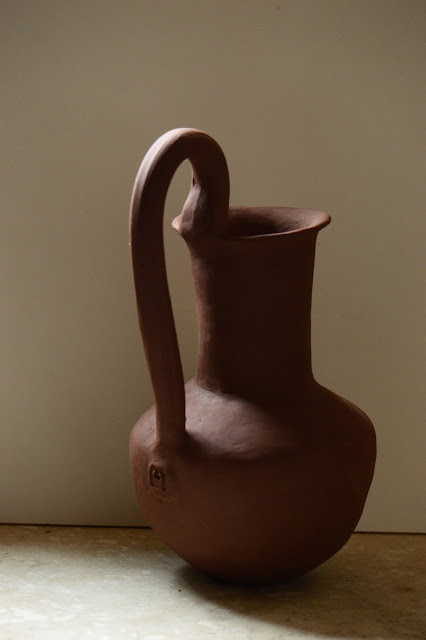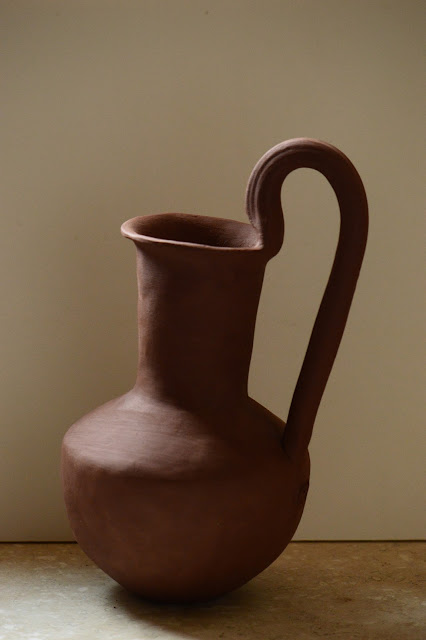Wednesday, August 31, 2016
Thursday, May 5, 2016
Technique and Resource
 |
| recent work, unfired earthenware vase |
I am finally making some progress again with the techniques involved in coil-built pottery. For a while it seemed as if I was getting nowhere, actually losing ground when I attempted to push the technical boundaries. My latest vase is much more controlled, and now I look forward to the next!
The breakthrough was due to taking some time to refresh my technical memory. Once more I had a close look at two very helpful videos available via YouTube. One is the old National Park Service documentary on the great potter of San Ildefonso, Maria Martinez. The other is footage of a workshop with Mata Ortiz master potter Jerardo Tena, in conjunction with the Orchard Valley Ceramics Art Guild. I am most grateful to the people who created these videos and have made them available for potters and, indeed, anyone at all interested in the craft.
Both have extensive footage of the hands at work, showing the movements and the response of the clay. In addition, both (and particularly the workshop with Sr. Tena) contain descriptions of the clays used and other information about handling the materials. I am including the links in case they may be of help or interest to my readers, as they certainly have been for me!
Sunday, March 20, 2016
A Sugar Bowl
...or, at any rate, a bowl for sugar.
This was a long overdue project as we had descended to the level of using a plastic cup! High time for the potter to be busy.
The upper section was coiled first, then allowed to firm up. It was then inverted and the foot coiled directly onto the base.
Made from my red earthenware clay, left entirely unglazed, and fired to Orton Cone 04 in about a 10 hour firing.
It has been in frequent use since!
This was a long overdue project as we had descended to the level of using a plastic cup! High time for the potter to be busy.
The upper section was coiled first, then allowed to firm up. It was then inverted and the foot coiled directly onto the base.
Made from my red earthenware clay, left entirely unglazed, and fired to Orton Cone 04 in about a 10 hour firing.
It has been in frequent use since!
Sunday, March 6, 2016
The Handknit Poncho
 |
| Handknit poncho. Photo by Sarah Myers, used by permission |
The poncho is a traditional wrap found up and down the Americas, from Chile to Mexico. It is a very simple garment, traditionally a handwoven rectangle with a slit for the neck (or perhaps two handwoven rectangles joined up the center with fancy stitching and separated at the neck).
In this case, I have chosen to handknit this design, which made it easy to add some simple shaping at the shoulder to reduce overall bulk on a small wearer, namely myself! This shaping was achieved by using what knitters refer to as "short rows", which produce a diagonal increase across the garment. It also produces the double row of eyelets seen along the shoulder.
 |
| photo courtesy Sarah Myers |
Otherwise, I have simply knitted a rectangle, split at the neck into two sections worked separately, then rejoined to work down the back. In other words, it is knit all in one piece with a straight opening at the neck.
Decoration is in garter stitch and stocking stitch. Garter stitch panels edge the entire garment as well as the central motive and neck. The rectangular pattern up the center is in variations of stocking stitch and reversed stocking stitch. Front and back are identical.
When I was quite small, I had a wrap which we called a poncho. It was in red yarn with a sort of netted construction. It was perhaps more accurately called a cape as it was circular with slits for the arms, and it was certainly more for looks than warmth! But I was always fascinated by it.
My recent version is considerably more effective as a wrap. I did, however, make it of cotton rather than wool, which could only really be used for a few weeks each year here in the desert. Already in March, there is no need to dress warmly, except occasionally in the evenings!
 |
| photo courtesy Sarah Myers |
Saturday, February 20, 2016
Testing the New Clay
 |
| Unfired piece created yesterday and now drying |
The increase in fireclay (I am using Hawthorn Bond) does appear to have strengthened the batch, allowing easier working properties with the coiling technique. In the past, I have added 35 mesh fireclay to produce a bit of 'tooth' in throwing clays without the texture resultant from use of grog. In this case, it is present to increase the structural strength during handbuilding. I used an increase of 3%, which is considerable in an earthenware clay, normally a fairly gentle, light-working body. I may opt for 2% next time, with the other 1% going to ball clay for a slight increase in plasticity.
As for the color, the fire will tell; and for that I must wait until the piece has dried sufficiently! In the meantime, I will continue to experiment with this batch as I rather liked the working properties.
Sunday, February 7, 2016
Fresh From the Fire 1
Unglazed pot in red clay,
handbuilt using traditional coiling methods,
fired to Orton cone 04,
6 in/15 cm high
Thursday, February 4, 2016
Friday, January 8, 2016
The Water Pot
Newly made, drying as slowly and evenly as I can manage, this is the most complex form that I have attempted in handbuilt pottery to date. It will need a bit more finish work, but that will wait until it is more or less completely dry. One process accident may have already fated this piece to remain a concept piece, as the handle was pulled slightly away during work. I've remedied this as well as I can, and I certainly hope the correction withstands the stresses of drying and firing. There will be more of these pots, whether or no. It was a very satisfying form to make.
Tuesday, January 5, 2016
Saturday, January 2, 2016
Glaze in the Making
The first full glaze test (and a small one, at that) is out of the kiln. While I have walked round and round the glaze options for the new earthenware clay, the slow thought has payed off in one respect, with a correctly melting and apparently usable glaze right from the first trial.
I say apparently because these tiles were fired in our tiny test kiln. With a much more rapid firing and cooldown, it cannot quite replicate the results of a regular ware fire. However, I am going to try #3 on some pieces soon. And then I will know a lot more. Probably!
This glaze makes use of ingredients from the region. Navajo pumice, mined in New Mexico, supplies both silica and alumina, two of the three main ingredients in most workable glazes. I have also used Gerstley borate, a calcium borate from Death Valley, California, an often maligned but often invaluable source of boron in glazes. It provides for a good, glassy melt and is probably the source of the bubbles in tiles #2, #3, and #4, though I can't say for sure yet. Also present is some baking soda as I needed sodium and was short on other sources! It is not normally used because it is soluble in the glaze batch; however, I decided it was worth a try, and I made my batch and used it immediately to avoid trouble.
I normally start my glaze calculations from the molecular formulae and then do line blends based on weight. So I will be able to substitute a different source of sodium once I get some more supplies, though there may be different results as few ingredients are quite as pure as chemical formulae... I have yet to analyze the mathematical results from this set, but look forward to doing that soon!
In the meantime, I am back at work with the clay after an enforced break over part of November and half of December. Cheers to the New Year!
I say apparently because these tiles were fired in our tiny test kiln. With a much more rapid firing and cooldown, it cannot quite replicate the results of a regular ware fire. However, I am going to try #3 on some pieces soon. And then I will know a lot more. Probably!
This glaze makes use of ingredients from the region. Navajo pumice, mined in New Mexico, supplies both silica and alumina, two of the three main ingredients in most workable glazes. I have also used Gerstley borate, a calcium borate from Death Valley, California, an often maligned but often invaluable source of boron in glazes. It provides for a good, glassy melt and is probably the source of the bubbles in tiles #2, #3, and #4, though I can't say for sure yet. Also present is some baking soda as I needed sodium and was short on other sources! It is not normally used because it is soluble in the glaze batch; however, I decided it was worth a try, and I made my batch and used it immediately to avoid trouble.
I normally start my glaze calculations from the molecular formulae and then do line blends based on weight. So I will be able to substitute a different source of sodium once I get some more supplies, though there may be different results as few ingredients are quite as pure as chemical formulae... I have yet to analyze the mathematical results from this set, but look forward to doing that soon!
In the meantime, I am back at work with the clay after an enforced break over part of November and half of December. Cheers to the New Year!
Subscribe to:
Posts (Atom)


















